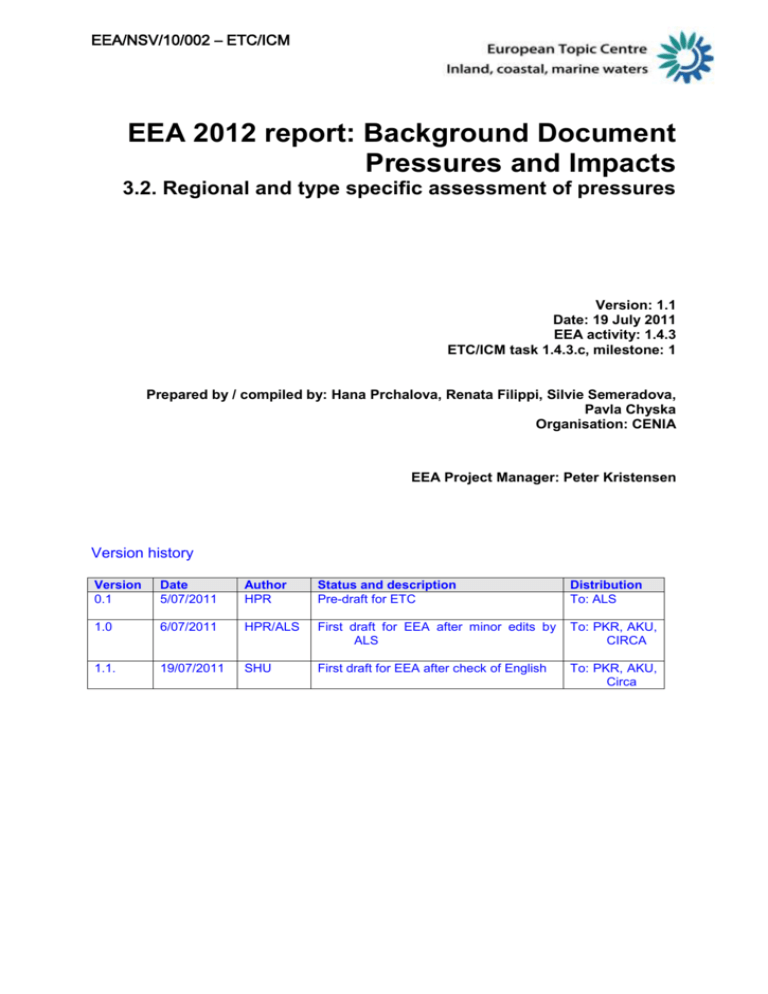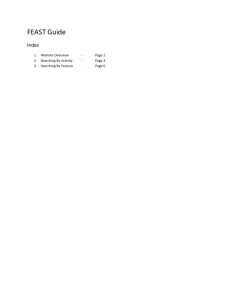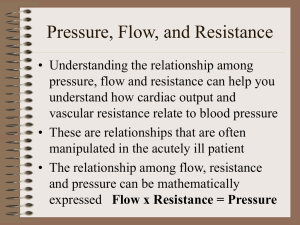Freshwater ecological status and related pressures
advertisement

EEA/NSV/10/002 – ETC/ICM EEA 2012 report: Background Document Pressures and Impacts 3.2. Regional and type specific assessment of pressures Version: 1.1 Date: 19 July 2011 EEA activity: 1.4.3 ETC/ICM task 1.4.3.c, milestone: 1 Prepared by / compiled by: Hana Prchalova, Renata Filippi, Silvie Semeradova, Pavla Chyska Organisation: CENIA EEA Project Manager: Peter Kristensen Version history Version 0.1 Date 5/07/2011 Author HPR Status and description Pre-draft for ETC Distribution To: ALS 1.0 6/07/2011 HPR/ALS First draft for EEA after minor edits by ALS To: PKR, AKU, CIRCA 1.1. 19/07/2011 SHU First draft for EEA after check of English To: PKR, AKU, Circa Abbreviations HPR: Hana Prchalova ALS: Anne Lyche Solheim Chapter 3.2. Regional and type specific assessment of pressures Introduction The structure of this document follows the same format as “Chapter 2.2. Ecological status and potential: Regional and type specific assessment”, and so does the numbering of figures - each figure number in this document refers to the relevant Figure in “Chapter 2.2”. The number of figures is higher, further the best ones will be selected. Key messages The shares of pressures in lakes are different for natural and heavily modified and artificial lakes. These differences play a more significant role in the results rather than in relation to the lake area. The group of countries considered having the best ecological status or potential (AT, FI, LT, SE) have more freshwater bodies with at least one significant pressure then the group with the least good ecological status (BE, DE, NL). The differences however are not substantial. The outputs of this analysis are more affected by the country specific methodologies of assessment and reporting of significant pressures then by natural characteristics and anthropogenic activities in the countries. The numbers of bodies with and without pressures confirm better ecological conditions in the upper Rhine area. Main diagrams The adequate diagram for Figures 1a and 1b was not prepared due to the late submission of RBD classification according to the sea region. The diagram will be prepared under the autumn deadline. Significant pressures of all lakes Relative distribution by count of different size classes Other 100% Other morphol TCW manag 80% River manag Morphology 60% Abstractions 40% Diffuse Point 20% 0% 0,51-1 0-0,5 1,01- 10,01- >100 10 100 Size class (km2) Figure 2a: Relative distribution by count of significant pressures of all European lake water bodies in different size classes. Significant pressures of natural lakes Relative distribution by count of different size classes Other 100% 90% 80% 70% 60% 50% 40% 30% 20% 10% 0% Other morphol TCW manag River manag Morphology Abstractions Diffuse Point 0,51-1 0-0,5 1,01- 10,01- >100 10 100 Size class (km2) Figure 2b: Relative distribution by count of significant pressures of natural European lake water bodies in different size classes Note: Numbers below columns represent area of lakes with pressures in thousands of km 2 Morphology represents Water flow regulations and morphological alterations of surface water Other morphology represents other morphological alterations – barriers or land sealing. Significant pressures of natural lakes Relative distribution by count of different size classes Other 100% 90% 80% 70% 60% 50% 40% 30% 20% 10% 0% Other morphol TCW manag River manag Morphology Abstractions Diffuse Point 0,51-1 0-0,5 1,01- 10,01- >100 10 100 Size class (km2) Figure 2c: Relative distribution by count of significant pressures of heavily modified and artificial European lake water bodies in different size classes Note: Numbers below columns represent area of lakes with pressures in thousands of km 2 Morphology represents water flow regulations and morphological alterations to surface water. Other morphology represents other morphological alterations – barriers or land sealing. Assessments 100% 80% 60% 40% 20% 0% AT, FI, LT, SE - lakes and rivers with pressure BE, DE, NL - lakes and rivers without pressure Figure 4a: Relative distribution by count of pressures of European freshwater bodies in the best and the least good countries. 100% 90% 80% 70% 60% no pressure 50% any pressure 40% 30% 20% 10% 0% AT, FI, LT, SE lakes AT, FI, LT, SE rivers BE, DE, NL lakes BE, DE, NL rivers Figure 4b: Relative distribution by count of pressures on lakes and rivers in the best and the least good countries. 100% 80% 60% 40% 20% any pressure - lakes and rivers NLRN DE3000 DE4000 DE5000 DE9650 DE2000 DE1000 SE3 AT1000 SE4 FIVHA3 SE5 LT1100 SE2 FIVHA2 FIVHA4 SE1 FIVHA1 SE1TO FIVHA5 FIVHA7 0% no pressure - lakes and rivers Figure 5a: Relative distribution by count of pressures of all freshwater bodies in the major RBDs (>15000 km2). The RBDs are sorted by the percentage of water bodies having good or high ecological status or potential (descending order). The vertical line marks the distinction between the best and the least good countries. BE does not have RBDs >15000 km2. 100% 90% 80% 70% 60% 50% 40% 30% 20% 10% any pressure - lake NLRN DE3000 DE4000 DE5000 DE9650 DE2000 DE1000 SE3 AT1000 SE4 FIVHA3 SE5 LT1100 SE2 FIVHA2 FIVHA4 SE1 FIVHA1 SE1TO FIVHA5 FIVHA7 0% no pressure - lake Figure 5b: Relative distribution by count of pressures of lakes in the major RBDs (>15000 km2). The RBDs are sorted by the percentage of water bodies having good or high ecological status or potential (descending order). The vertical line marks the distinction between the best and the least good countries. BE does not have RBDs >15000 km2. 100% 90% 80% 70% 60% 50% 40% 30% 20% 10% any pressure - river NLRN DE3000 DE4000 DE5000 DE9650 DE2000 DE1000 SE3 AT1000 SE4 FIVHA3 SE5 LT1100 SE2 FIVHA2 FIVHA4 SE1 FIVHA1 SE1TO FIVHA5 FIVHA7 0% no pressure - river Figure 5c: Relative distribution by count of pressures of rivers in the major RBDs (>15000 km2). The RBDs are sorted by the percentage of water bodies having good or high ecological status or potential (descending order). The vertical line marks the distinction between the best and the least good countries. BE does not have RBDs >15000 km2. 100% 80% 60% 40% 20% 0% AT2000 DE2000 any pressure - lakes and rivers FRC NLRN no pressure - lakes and rivers Figure 6a: Relative distribution by count of pressures of freshwater bodies in the RBDs along the Rhine river. The RBDs are sorted from headwater to coast. 100% 80% 60% 40% 20% 0% AT2000 DE2000 any pressure - lake FRC NLRN no pressure - lake Figure 6b: Relative distribution by count of pressures of lakes in the RBDs along the Rhine river. The RBDs are sorted from headwater to coast. 100% 80% 60% 40% 20% 0% AT2000 DE2000 any pressure - river FRC NLRN no pressure - river Figure 6c: Relative distribution by count of pressures of rivers in the RBDs along the Rhine river. The RBDs are sorted from headwater to coast. The structures of types of pressures in lakes are different for natural and heavily modified and artificial lakes (see Figures 2a -2c). These differences are significant enough to overrun any lake area-related correlation. Generally, the lakes with diffuse sources of pollution are still considered to take up the greatest share, but from the reported data it can not be determined if the pollution comes from nutrients, other generally physico-chemical substances or priority substances. The group of countries considered having the best ecological status or potential (AT, FI, LT, SE) have 78% of freshwater bodies with at least one significant pressure, while the group with the least good ecological status or potential have 91% of freshwater bodies with at least one significant pressure (see Figure 4a an 4b). The share of rivers with at least one pressure is slightly bigger (83% to 92%) than the corresponding share of lakes (67% to 76%). A more detailed analysis shows, however, that the results are affected by the different, country specific assessment and reporting methodologies to such an extent that no linear trends can be derived (AT, FI and most of LT reported significant pressures only for the bodies in less then good status, while BE, E, NL an Sweden reported pressures also for bodies with good and above status). The number of bodies with at least one pressure is significantly lower in the upper Rhine area (except for rivers in Germany), but even here the assessment is still affected by the differences in reporting. The detailed information on the diffuse and point sources was reported only by some countries. For this analysis, France (with the overseas departments excluded) was chosen, however the detailed information on some of its water bodies was still missing – see Figures 7, 8 and 9. 100% 80% 60% 40% 20% 0% FRA FRB1 FRB2 FRC FRD FRE FRF FRG FRH Point Source Point - UWWT total Point - Storm Overflows Point - IPPC plants (EPRTR) Point - Non IPPC Point - Other Figure 7: Proportional share of point pressures in rivers by RBDs in France (overseas departments not included). Note: Point Source represents the share of bodies for which the point pressures were not further specified. 100% 80% 60% 40% 20% 0% FRA FRB1 FRB2 FRC FRD FRE FRF FRG Point - UWWT_General Point - UWWT_2000 Point - UWWT_10000 Point - UWWT_15000 Point - UWWT_150000 Point - UWWT_150000PLUS FRH Figure 8: Proportional share of discharge to rivers from UWWTPs according to size, by RBDs, in France (overseas departments not included). Note: Point -UWWT_General represents the share of bodies for which the discharge was not further specified according to size. 100% 80% 60% 40% 20% 0% FRA FRB1 FRB2 FRC FRD FRE FRF FRG FRH Diffuse Source Diffuse - Urban run off Diffuse - Agricultural Facilities not connected to sewerage Diffuse - Other Figure 9: Proportional share of diffuse pressures types for rivers by RBDs in France (overseas departments not included). Note: Diffuse Source represents the share of bodies for which the diffuse sources were not further specified. Background Information Water Framework Directive, Annex II, Art. 1.4: Member States shall collect and maintain information on the type and magnitude of the significant anthropogenic pressures to which the surface water bodies in each river basin district are liable to be subject. This information includes: estimation and identification of significant point and diffuse source pollution, in particular by substances listed in Annex VIII of WFD, from urban, industrial, agricultural and other installations and activities; estimation and identification of significant water abstraction for urban, industrial, agricultural and other uses, including seasonal variations and total annual demand, and of loss of water in distribution systems; estimation and identification of the impact of significant water flow regulation, including water transfer and diversion, on overall flow characteristics and water balances; identification of significant morphological alterations to water bodies and estimation and identification of other significant anthropogenic impacts on the status of surface waters. According to Annex VII of the WFD, the RBMP should include: a summary of significant pressures and impact of human activity on the status of surface water and groundwater, including: o estimation of point source pollution, o estimation of diffuse source pollution, including a summary of land use, o estimation of pressures on the quantitative status of water including abstractions, o analysis of other impacts of human activity on the status of water. Specific Guidance documents were established for the 1st RBMP cycle - Analysis of Pressures and Impacts (Policy summary) and Analysis of Pressures and Impacts – Guidance Document No. 3. Pressures and impacts analyses have a central role in the river basin management planning process. Their principal aim is to identify where and to what extent human activities may be placing the achievement of the Directive’s environmental objectives at risk. In this Guidance document, significant pressures were unequivocally understood as those anthropogenic pressures which can cause not reaching good status (and so were they reported within Characterisation). The inventory of pressures is likely to contain many that have no, or little, impact on the water body. In the case of surface waters, the WFD recognises this by only requiring significant pressures to be identified, and within this Guidance significant is interpreted as meaning that the pressure contributes to an impact that may result in the failing of an objective. (Pressures and Impacts – Guidance document No. 3, ch. 3.3.1) Although Guidance Document No. 21: Guidance for reporting under the Water Framework Directive referred to significant pressures as only those pressures which caused not reaching good status (i.e. not which can cause), this was not explicitly mentioned in the Guidance document. The following compliance indicators relating to surface waters will be used: Number of water bodies failing to reach good status/potential as a result of each pressure; Number of water bodies or river length etc/Sub-unit "not in good status/potential" as a result of point sources (either as a result of point sources only or in combination with other pressures); Guidance document No. 21: Guidance for reporting under the Water Framework, ch. 7.2, p. 46. Methodology Surface water pressures are assigned to a water body and chosen from the relevant enumeration list. Values in the enumeration list can be divided into three levels of detail. The enumeration list consists of 65 values, therefore the data used in the analysis were aggregated at the highest level (Table I). One water body can be assigned with more pressures. To avoid a multiple inclusion of one water body - or its length/area - in the statistics, which can be misleading, every aggregated pressure was included only once. Example: if the water body was assigned with 1.1.2 Point - UWWT_10000 and 1.3 Point IPPC plants (EPRTR), the aggregated point source pressure was included only once. For pressures from diffuse and point sources, both the highest level pressure (e.g. Diffuse Source) and lower level pressure (e.g. Diffuse – Agricultural) are given for some bodies. Specifically it concerns 7 water bodies in France for point sources and 1750 bodies in Sweden and 4 in France for diffuse sources. This also needed to be taken into account for the statistics. Each water body can have up to 8 aggregated pressures. Therefore, if the share of diffuse point sources in natural lakes is 54% and in heavily modified lakes 34%, it does not necessarily mean that only 54% (or 34%) of the bodies have a diffuse source or that diffuse sources affect significantly lower share of heavily modified and artificial lakes then natural ones. In reality, diffuse sources affect 85% of natural lakes an 77% heavily modified an artificial lakes, but for the latter category they occur in 74% of bodies simultaneously, which means that the total share of diffuse sources gets significantly lower. Apart from different natural environments (which determines the vulnerability of a water body towards pressures) and the extent of anthropogenic activities, the total share of diffuse and point pressures in individual countries or RBDs is affected (often more significantly) by the different methodology of determining significant pressures, different understanding of what is a significant pressure, number of bodies in less then good status, and the quality of reporting. Enumeration list of SW point and diffuse pressures Aggregated SW point and diffuse pressures 1 Point Source 2 Diffuse Source 1.1 Point - UWWT_General 1.1.1 Point - UWWT_2000 1.1.2 Point - UWWT_10000 1.1.3 Point - UWWT_15000 1.1.4 Point - UWWT_150000 1.1.5 Point - UWWT_150000PLUS 1.2 Point - Storm Overflows 1.3 Point - IPPC plants (EPRTR) 1.4 Point - Non IPPC 1.5 Point - Other 2.1 Diffuse - Urban run off 2.2 Diffuse - Agricultural 2.3 Diffuse - Transport and infrastructure 2.4 Diffuse - Abandoned industrial sites 2.5 Diffuse - Releases from facilities not connected to sewerage network 2.6 Diffuse - Other Point Source Diffuse Source Point - UWWT General Point - UWWT General Point - UWWT General Point - UWWT General Point - UWWT General Point - UWWT General Point Source Point Source Point Source Point Source Diffuse Source Diffuse Source Diffuse Source Diffuse Source Diffuse Source Diffuse Source Table I: Aggregated e point and diffuse pressures in surface waters References DIRECTIVE 2000/60/EC OF THE EUROPEAN PARLIAMENT AND OF THE COUNCIL of 23 October 2000 establishing a framework for Community action in the field of water policy POLICY SUMMARY to Guidance Document No 3 Analysis of Pressures and Impacts Guidance Document No. 3 Analysis of Pressures and Impacts Guidance Document No. 21 Guidance for reporting under the Water Framework Directive




![[09]. Strategies for Growth and Managing the Implications of Growth](http://s2.studylib.net/store/data/005486524_1-1f063ac78a31ad020721eab31440cecf-300x300.png)


